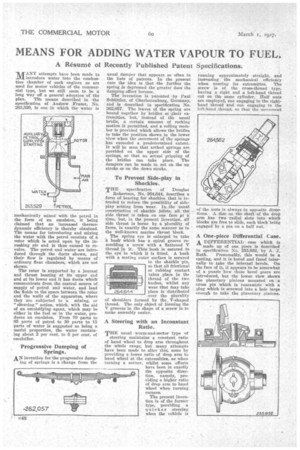MEANS FOR ADDING WATER VAPOUR TO FUEL
Page 70

If you've noticed an error in this article please click here to report it so we can fix it.
A Résumé of Recently Published Patent Specifications.
MANY attempts have been made to introduce water into the combustion chamber of suchengines as are used for motor vehicles of the commercial type, but we still seem to be a long way off a general adoption of the
plan. The means described in the specification of Andrew Fraser, No. 268,529, is one in which the water is
mechanically mixed with the petrol in the form of an emulsion, it being Claimed that an increased thermodynamic efficiency is thereby obtained. The means for introducing and mixing the water with the petrol consists of a rotor which is acted upon by the inrushing air and is thus caused to revolve. The petrol and water are introduced through the ducts shown, and their flow is regulated by means of ordinary float chambers, which are not shown.
The rotor is supported by a journal and thrust bearing at its upper end and at its lower end it has ducts whielt communicate from the central source of supply of petrol and water, and lead the fluids to the space between the rotor and the walls of the apparatus, where they are subjected to a mixing, or shearing" action, which, with the aid of an emulsifying agent, which may be either in the fuel or in the water, produces an emulsion. From 70 parts to 85 parts of petrol to 80 parts to 15 parts of water is suggested as being a useful proportion, the water containing about 2 per cent. to 5 per cent. of emulsifier.
Progressive Damping of Springs.
AN invention for the progressive damping of springs is a change from the
usual damper that appears so often in the lists of patents. In the present case the idea is that the further the spring is depressed the greater does the damping effect become.
The invention is • pftteeted by Paul' Selnittler, of Oharlottenburg, Germany, and is described in specification No. 262,057. The leaves of the 'spring are bound together by bridles at \their extremities, but, instead of the usual bridle, a certain amount of rocking motion is permitted, and a rolling member is provided which allows the bridles to take the position shown in the lower view when the ,novement of the springs has exceeded a predetermined extant.. It will be seen that arched springs are provided on the upper side of the springs, so that no actual gripping of the bridles can take place. The dampers can be made to net on the up stroke or on the down stroke.
To Prevent Side-play in Shackles.
THE specification of Douglas Robertson, No. 264,644, describes a form of bearing for shackles that is intended to reduce the possibility of sideplay arising from wear. In the usual construction of shackle joints, all the side thrust is taken on one face at a' time, but, in the present invention, all side thrust is borne by a plurality of faces, in exactly the same manner as in the well-known marine thrust block. The spring eye is enlarged to take a bush which has a spiral groove resembling a screw with It flattened V thread in it. This bush is secured to the eye in which it is fitted. A bush with a mating outer surface is secured to the shackle pin, so that all frictional or rubbing contact takes place in the thread of the two bushes, whilst any wear that May take place is distributed over the plurality of shoulders formed by the. V-shaped thread. The only object of forming the V grooves in the shape of a screw is to make assembly easier.
A Steering with an Inconstant Ratio.
THE usual worm-and-sector type of steering maintains a constant ratio of hand wheel to drop arm throughout the whole range, but many attempts have been made to alter this; some by providing a lower ratio of drop arm to hand wheel at the extremities, as when turning a corner, whilst some efforts have been in exactly the opposite direction, namely, providing a higher ratio of drop arm to band wheel when turning corners.
The present invention is of the former type, providing a quicker steering when the vehicle is
running approximately straight, and increasing the mechanical efficieney when nearing its extremities. The screw is of the cross-thread type, • having a right and a left-hand thread cut on the same cylinder. Half nuts are employed, one engaging in the righthand thread and One engaging in the left-hand thread, so that the movement of the nuts is always in opposite directions. A. disc on the shaft Of the drop arm has two radial slots into which blocks are free to slide, each block being engaged by a pin on a half nut.
A One-piece Differential Case, A DIFFERENTIAL case which is made up of one piece is described in specification No. 255,952, by A. .T.
Rath. Presumably, this would be a casting, and it is bored and faced internally• to take the internal bevels. On the face of it, it appears to be somewhat of a puzzle how these bevel gears are introduced, but the lower view shows the planetary pinions mounted on .a cross pin which is concentric with a plug which is screwed into a hole large enough to take the planetary pinions.












































































































